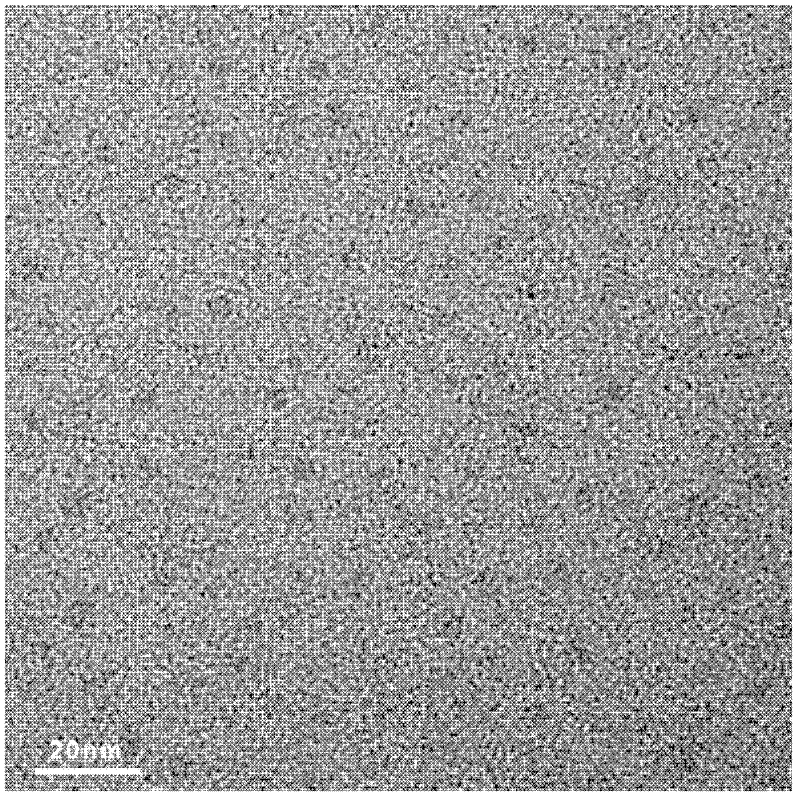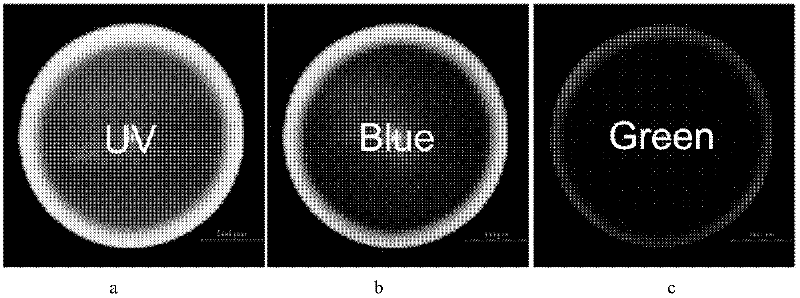Preparation method and applications of amino carbon quantum dots
A technology of aminocarbon quantum and carbon quantum dots, which is applied in the fields of chemistry and nanomaterial science, can solve the problems of difficult large-scale production promotion, cumbersome process steps, and human health pollution, and achieves easy promotion, simple preparation process equipment, and low cost Effect
- Summary
- Abstract
- Description
- Claims
- Application Information
AI Technical Summary
Problems solved by technology
Method used
Image
Examples
Embodiment 1
[0022] Embodiment 1: 0.5g glucosamine powder is put into the beaker of 100mL specification, injects 30ml concentration and is the Na of 10mmol / L in the beaker again 2 HPO 4 -NaH 2 PO 4 Aqueous solution (PH7.4), magnetically stirred at room temperature (15-25°C), until the glucosamine is fully dissolved to obtain a uniform transparent solution; put the beaker in the center of the turntable in a household mechanical microwave oven, use 700W power, to transparent The solution was subjected to microwave radiation for 2 minutes to obtain a brownish-yellow solution containing carbon quantum dots. After the solution was naturally cooled, it was injected into a dialysis bag (molecular weight cut-off 500D) for dialysis for 72 hours, and the water was changed every 12 hours. Most of the dialysis products were removed by rotary evaporation. water to obtain a concentrated solution. The obtained concentrated solution was freeze-dried at -50°C to finally obtain carbon quantum dots with a...
Embodiment 2
[0023] Embodiment 2: 0.5g glucosamine powder is put into the 100mL beaker, then in the beaker, inject 30ml concentration and be the Na of 20mmol / L 2 HPO 4 -NaH 2 PO 4 Aqueous solution (pH7.4), magnetically stirred at room temperature, until the glucosamine is fully dissolved to obtain a uniform transparent solution; place the beaker in the center of the turntable in a household mechanical microwave oven, and use 700W power to irradiate the transparent solution with microwaves for 2 minutes. Obtain a brown-red solution containing carbon quantum dots. After the solution is naturally cooled, it is poured into a dialysis bag (molecular weight cut-off 500D) for dialysis for 72 hours, and the water is changed every 12 hours. Most of the water is removed from the dialysis product by rotary evaporation to obtain a concentrated solution. The obtained concentrated solution was freeze-dried at -50°C to finally obtain carbon quantum dots with amino groups on the surface, the yield was a...
Embodiment 3
[0024] Embodiment 3: 0.5g glucosamine powder is put into 100mL beaker, inject 30ml concentration in beaker again and be the Na of 50mmol / L 2 HPO 4 -NaH 2 PO 4 Aqueous solution (PH7.4), magnetically stirred at room temperature, until the glucosamine is fully dissolved to obtain a uniform transparent solution; place the beaker in the center of the turntable in a household mechanical microwave oven, and use 700W power to irradiate the transparent solution with microwaves for 2 minutes. A brown solution containing carbon quantum dots was obtained. After the solution was naturally cooled, it was poured into a dialysis bag (MWCO 500D) for dialysis for 72 hours, and the water was changed every 12 hours. Most of the water was removed from the dialysis product by rotary evaporation to obtain a concentrated solution. The obtained concentrated solution was freeze-dried at -50°C to finally obtain carbon quantum dots with amino groups on the surface, with a yield of about 17%, a particle...
PUM
| Property | Measurement | Unit |
|---|---|---|
| Particle size | aaaaa | aaaaa |
Abstract
Description
Claims
Application Information
 Login to View More
Login to View More - R&D
- Intellectual Property
- Life Sciences
- Materials
- Tech Scout
- Unparalleled Data Quality
- Higher Quality Content
- 60% Fewer Hallucinations
Browse by: Latest US Patents, China's latest patents, Technical Efficacy Thesaurus, Application Domain, Technology Topic, Popular Technical Reports.
© 2025 PatSnap. All rights reserved.Legal|Privacy policy|Modern Slavery Act Transparency Statement|Sitemap|About US| Contact US: help@patsnap.com



